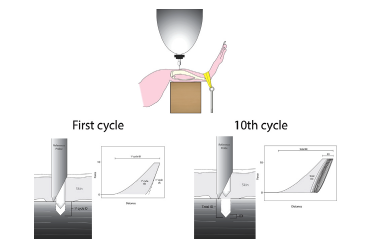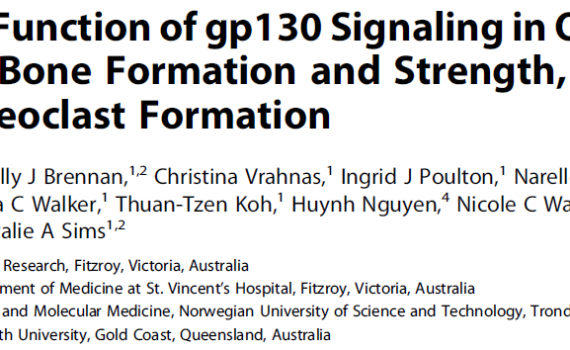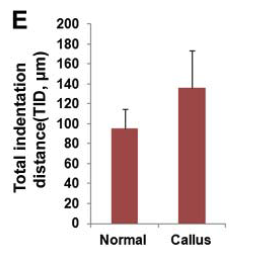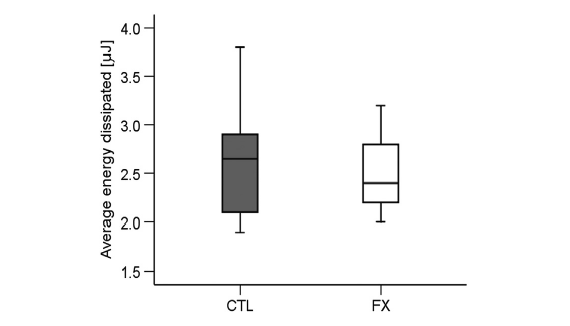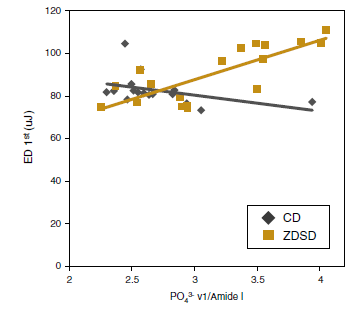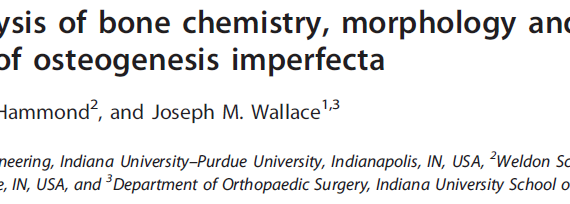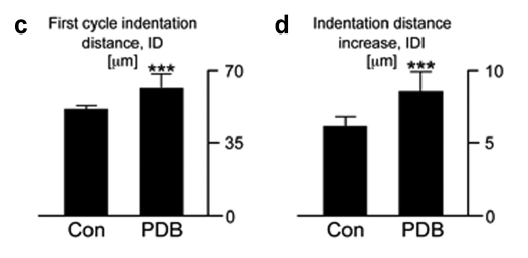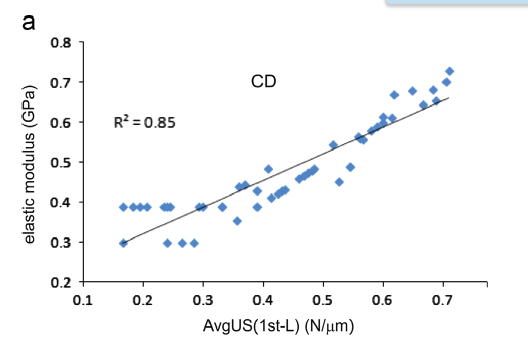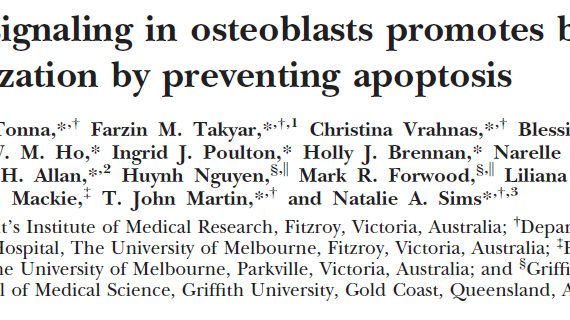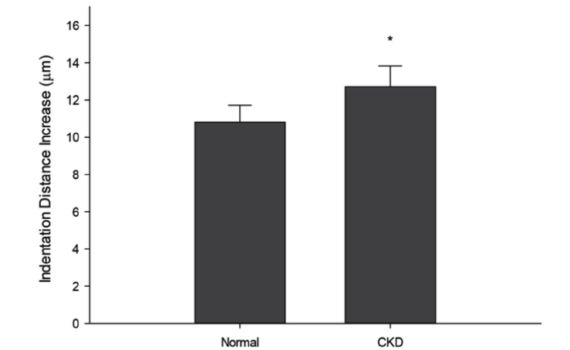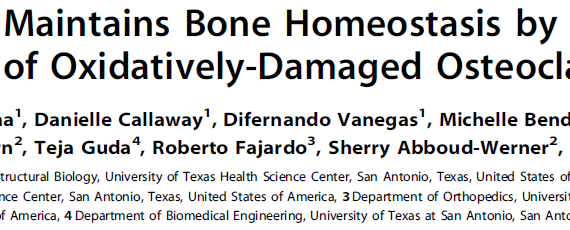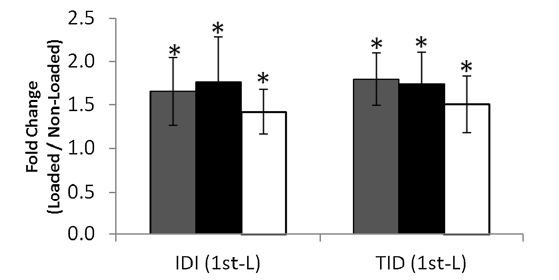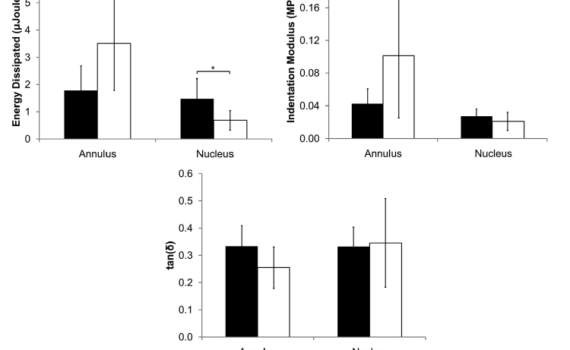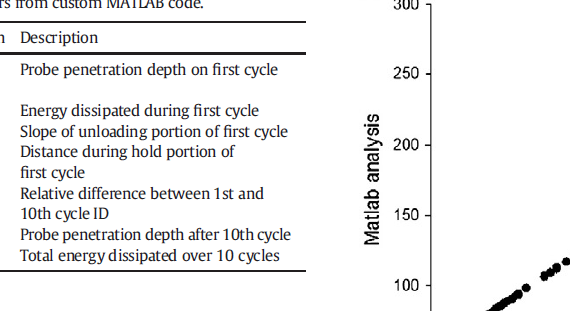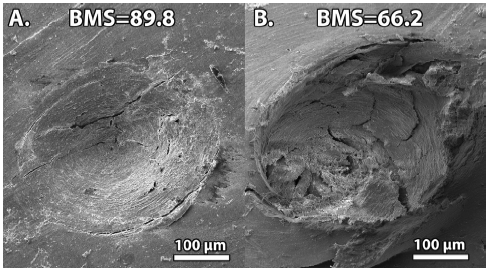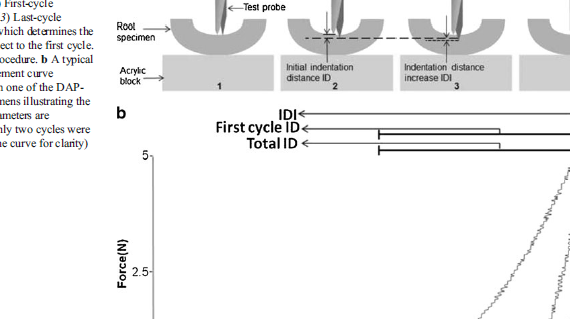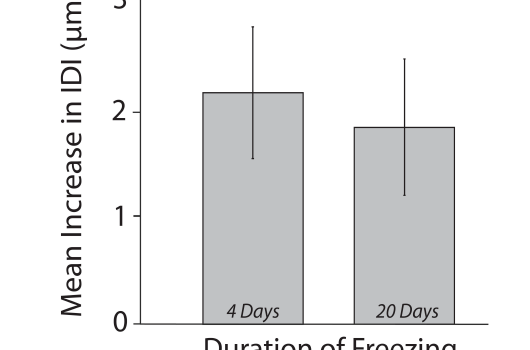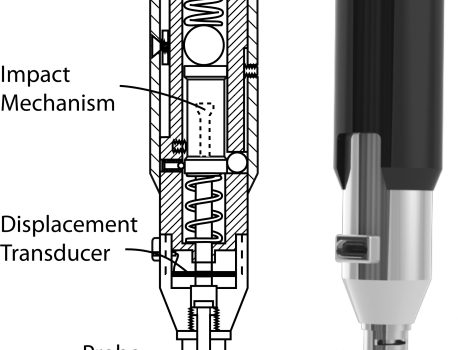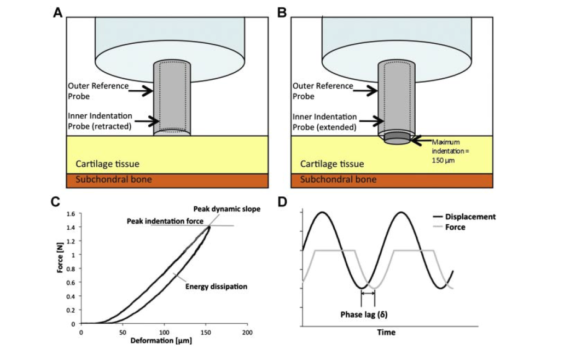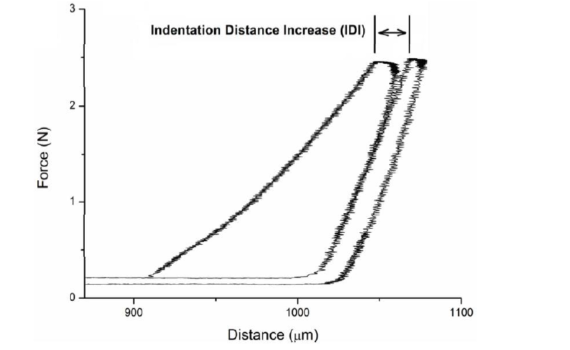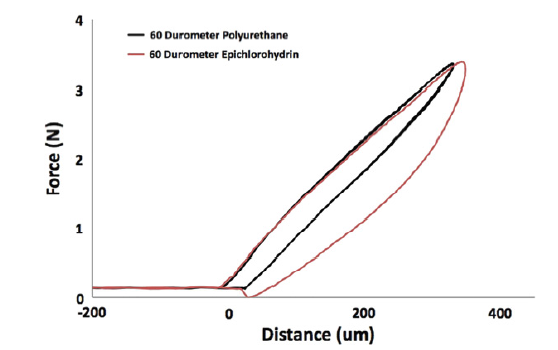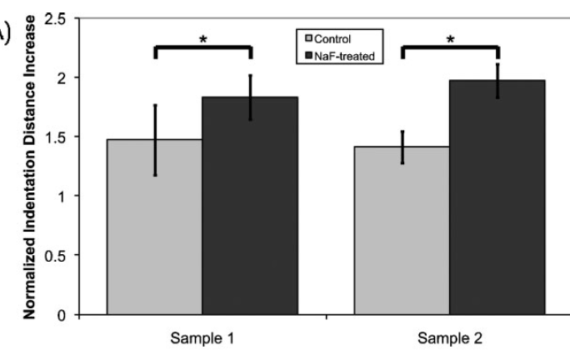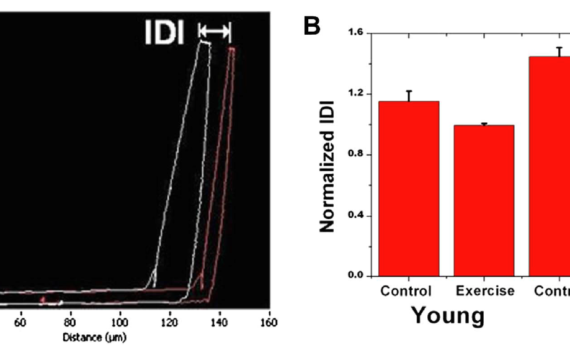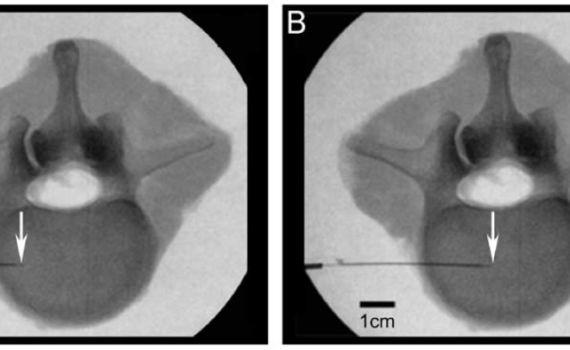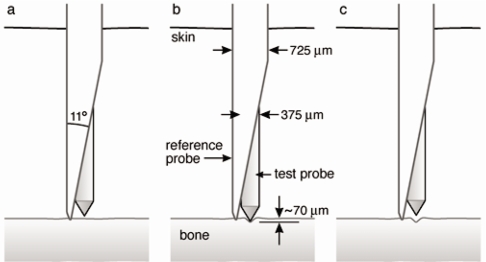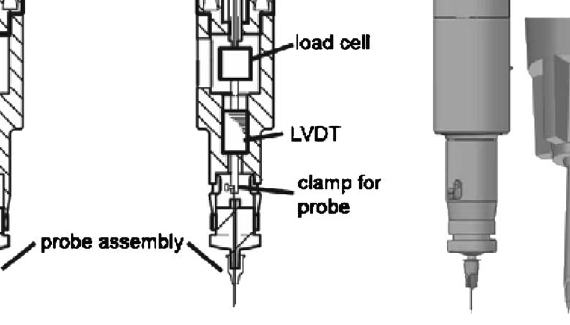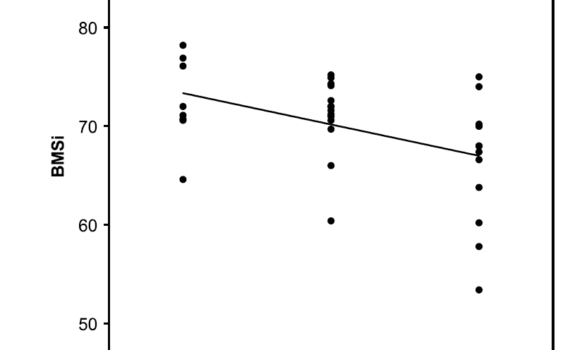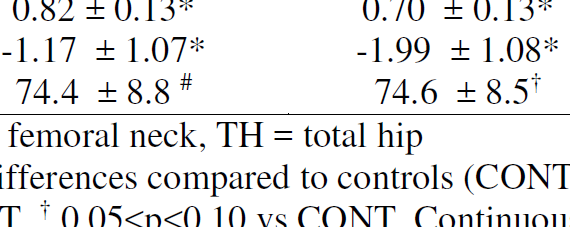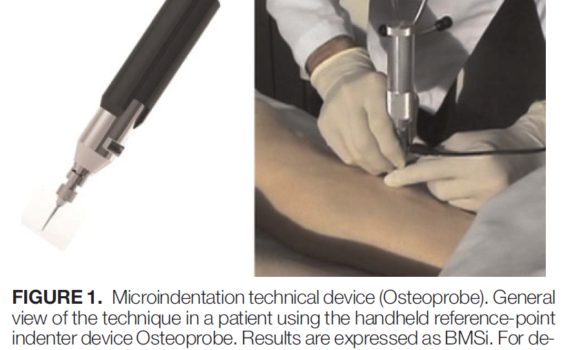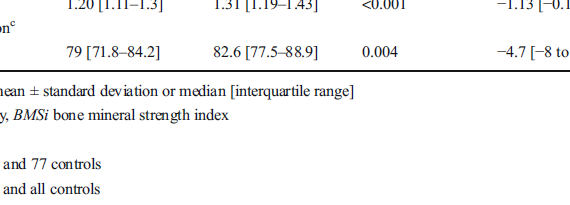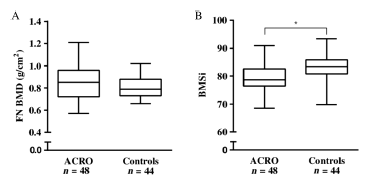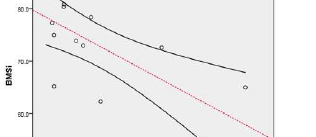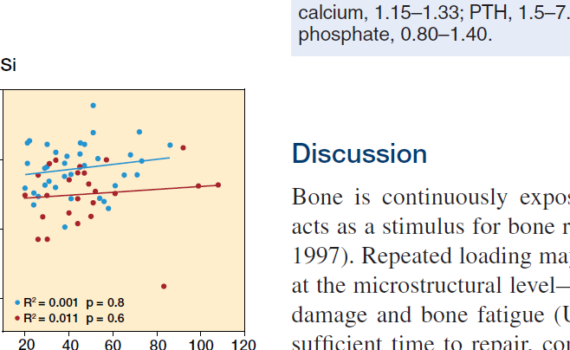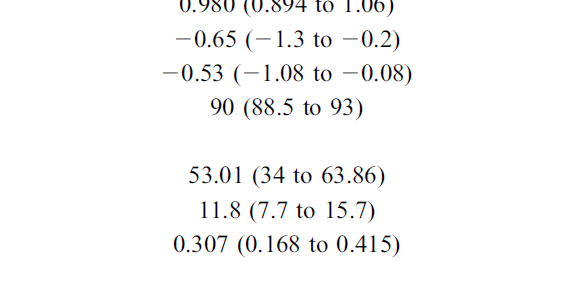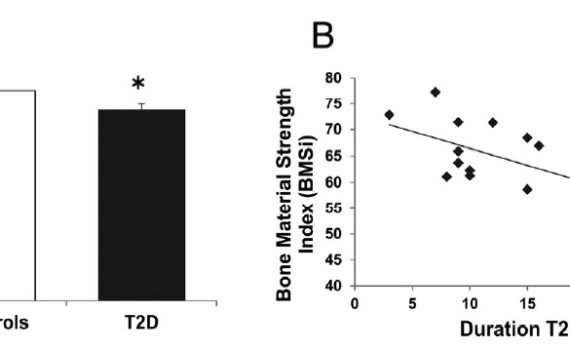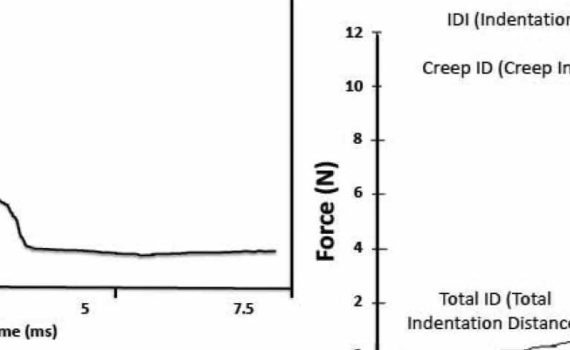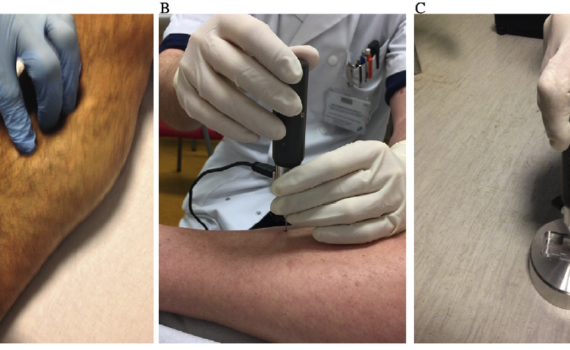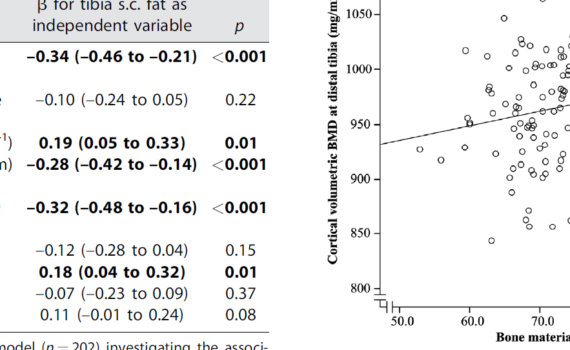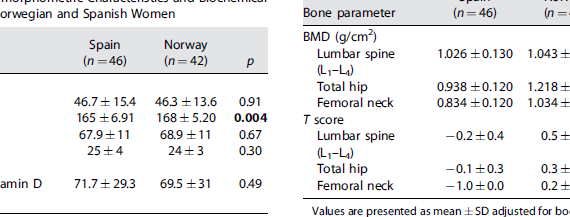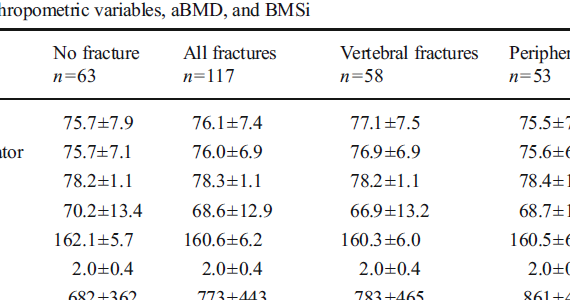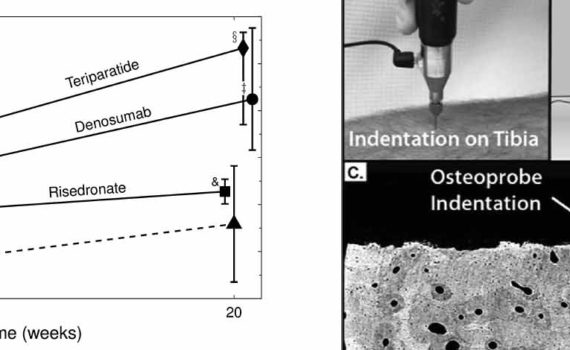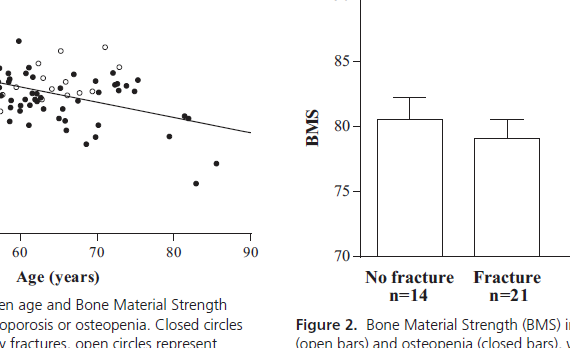Abstract The objective of this study was to determine the effects of various irrigation solutions on root canal dentine and gutta-percha surface properties. In addition, the effects of disinfectant chemicals on the wettability and surface morphological properties of the filling materials were evaluated. Ethylenediaminetetraacetic acid (EDTA), citric acid, and ozone […]
Daily Archives: July 20, 2018
Abstract Age- and disease (osteoporotic fractured and osteoarthritic tissue)-related changes in the distribution of cortical bone were examined, using a multimodality approach, including measurement of local density, geometry and mechanical properties, where changes in these properties can give rise to instability and increasing probability of fracture. In contrast to the […]
Abstract The degradation of the main fibrillar collagens, collagens I and II, is a crucial process for skeletal development. The most abundant dipeptides generated from the catabolism of collagens contain proline and hydroxyproline. In humans, prolidase is the only enzyme able to hydrolyze dipeptides containing these amino acids at their […]
We would like to thank Allen and colleagues for their thorough review of reference point indentation (RPI) for assessing bone mechanical properties in vivo.(1) The authors have focused on two separate RPI devices, the BioDent® and the OsteoProbe®, and have gone to great lengths to compare and contrast these instruments, which differ considerably […]
Abstract OBJECTIVE: To compare results obtained with a handheld reference point indentation instrument for bone material strength index (BMSi) measurements in the equine third metacarpal bone for various testing conditions. SAMPLE: 24 third metacarpal bones. PROCEDURES: Third metacarpal bones from both forelimbs of 12 horses were obtained. The dorsal surface […]
Abstract Diabetes and osteoporosis are both common diseases with increasing prevalences in the aging population. There is increasing evidence corroborating an association between diabetes mellitus and bone. This review will discuss the disease complications of diabetes on the skeleton, highlighting findings from epidemiological, molecular, and imaging studies in animal models […]
Abstract Although low bone mineral density (BMD) is strongly associated with increased fracture risk, up to 50% of those who suffer fractures are not detected as high-risk patients by BMD testing. Thus, new approaches may improve identification of those at increased risk for fracture by in vivo assessment of altered […]
Abstract Type 1 collagen matrix volume, its degree of completeness of its mineralization, the extent of collagen crosslinking and water content, and the non-collagenous proteins like osteopontin and osteocalcin comprise the main constituents of bone’s material composition. Each influences material strength and change in different ways during advancing age, health, […]
Abstract Deformations of vertebrae and sudden fractures of long bones caused by essentially normal loading are a characteristic problem in osteoporosis. If the loading is normal, then the explanation for and prediction of unexpected bone failure lies in understanding the mechanical properties of the whole bone-which come from its internal […]
Abstract In addition to the loss in bone volume that occurs with age, there is a decline in material properties. To test new therapies or diagnostic tools that target such properties as material strength and toughness, a pre-clinical model of aging would be useful in which changes in bone are […]
Abstract In the present study, the possibility that a diabetic (DM) status might worsen age-related bone deterioration was explored in mice. Male CD-1 mice aged 2 (young control group) or 16 months, nondiabetic or made diabetic by streptozotocin injections, were used. DM induced a decrease in bone volume, trabecular number, […]
Abstract Non-enzymatic glycation (NEG) is an age-related process accelerated by diseases like diabetes, and causes the accumulation of advanced glycation end-products (AGEs). NEG-mediated modification of bone’s organic matrix, principally collagen type-I, has been implicated in impairing skeletal physiology and mechanics. Here, we present evidence, from in vitro and in vivo […]
Abstract Type 2 diabetes mellitus (T2DM) represents a complex clinical scenario of altered energy metabolism and increased fracture incidence. The C57BL/6 mouse model of diet-induced obesity has been used to study the mechanisms by which altered glucose homeostasis affects bone mass and quality, but genetic variations in substrains of C57BL/6 […]
Abstract Type 2 diabetes (T2D) incidence in adolescents is rising and may interfere with peak bone mass acquisition. We tested the effects of early-onset T2D on bone mass, microarchitecture, and strength in the TALLYHO/JngJ mouse, which develops T2D by 8 weeks of age. We assessed metabolism and skeletal acquisition in […]
Abstract Reference point indentation (RPI) has emerged as a novel tool to measure material-level biomechanical properties in vivo. Human studies have been able to differentiate fracture versus non-fracture patients while a dog study has shown the technique can differentiate drug treatment effects. The goal of this study was to extend this […]
Abstract Increased fracture risk, traditionally associated with type 1 diabetes, has lately been of great concern in patients with type 2 diabetes. A variable increase in fracture risk has been reported, ranging from 20% to 3-fold, depending on skeletal site, diabetes duration and study design. Longer disease duration, the presence […]
Abstract Interleukin-6 (IL-6) family cytokines act via gp130 in the osteoblast lineage to stimulate the formation of osteoclasts (bone resorbing cells) and the activity of osteoblasts (bone forming cells), and to inhibit expression of the osteocyte protein, sclerostin. We report here that a profound reduction in trabecular bone mass occurs […]
Abstract Bone fragility has emerged as a new complication of diabetes. Several mechanisms in diabetes may influence bone homeostasis by impairing the action between osteoblasts, osteoclasts, and osteocytes and/or changing the structural properties of the bone tissue. Some of these mechanisms can potentially alter the fate of mesenchymal stem cells, […]
Comment on Sclerostin deficiency is linked to altered bone composition. [J Bone Miner Res. 2014] https://www.ncbi.nlm.nih.gov/pubmed/25158054 J Bone Miner Res. 2014 Oct;29(10):2141-3. doi: 10.1002/jbmr.2346.
Abstract Murine muscle-derived stem cells (MDSCs) have been shown capable of regenerating bone in a critical size calvarial defect model when transduced with BMP 2 or 4; however, the contribution of the donor cells and their interactions with the host cells during the bone healing process have not been fully […]
Abstract Polycystin-1 (Pkd1) interacts with polycystin-2 (Pkd2) to form an interdependent signaling complex. Selective deletion of Pkd1 in the osteoblast lineage reciprocally regulates osteoblastogenesis and adipogenesis. The role of Pkd2 in skeletal development has not been defined. To this end, we conditionally inactivated Pkd2 in mature osteoblasts by crossing Osteocalcin (Oc)-Cre;Pkd2+/null mice with floxed Pkd2 (Pkd2flox/flox) mice. Oc-Cre;Pkd2flox/null(Pkd2Oc-cKO) mice exhibited […]
Abstract To unravel the origins of decreased bone strength in the superolateral femoral neck, we assessed bone structural features across multiple length scales at this cortical fracture initiating region in postmenopausal women with hip fracture and in aged-matched controls. Our combined methodological approach encompassed atomic force microscopy (AFM) characterization of […]
Abstract Diabetes detrimentally affects the musculoskeletal system by stiffening the collagen matrix due to increased advanced glycation end products (AGEs). In this study, tibiae and tendon from Zucker diabetic Sprague-Dawley (ZDSD) rats were compared to Sprague-Dawley derived controls (CD) using Atomic Force Microscopy. ZDSD and CD tibiae were compared using […]
Abstract Osteogenesis imperfecta is a congenital disease commonly characterized by brittle bones and caused by mutations in the genes encoding Type I collagen, the single most abundant protein produced by the body. The oim model has a natural collagen mutation, converting its heterotrimeric structure (two α1 and one α2 chains) […]
Abstract Paget’s disease of bone (PDB) is the second most common bone disease mostly developing after 50 years of age at one or more localized skeletal sites; it is associated with severely high bone turnover, bone enlargement, bowing/deformity, cracking, and pain. Here, to specifically address the origins of the deteriorated […]
Abstract While insulin-like growth factor I is a well-known anabolic agent in bone evidence is beginning to accumulate that its homologue, insulin, also has some anabolic properties for bone. There is specific evidence that insulin may work to stimulate osteoblast differentiation, which in turn would enhance production of osteocalcin, the osteoblast-produced peptide […]
Abstract To improve bone strength prediction beyond limitations of assessment founded solely on the bone mineral component, we investigated the effect of hyperlipidemia, present in more than 40% of osteoporotic patients, on multiscale structure of murine bone. Our overarching purpose is to estimate bone strength accurately, to facilitate mitigating fracture […]
Abstract Cells that form bone (osteoblasts) express both ephrinB2 and EphB4, and previous work has shown that pharmacological inhibition of the ephrinB2/EphB4 interaction impairs osteoblast differentiation in vitro and in vivo. The purpose of this study was to determine the role of ephrinB2 signaling in the osteoblast lineage in the […]
Abstract Anti-resorptive and anabolic agents are often prescribed for the treatment of osteoporosis continuously or sequentially for many years. However their impact on cortical bone quality and bone strength is not clear. Methods Six-month old female rats were either sham operated or ovariectomized (OVX). OVX rats were left untreated for […]
Abstract Chronic kidney disease (CKD), which leads tocortical bone loss and increasedporosity,increases therisk of fracture. Animal models have confirmed that these changes compromise whole bone mechanical properties. Estimates from whole bone testing suggest that material properties are negatively affected, though tissue-level assessmentshavenot been conducted. Therefore, the goal of the present […]
Abstract Osteoporosis is a silent disease, characterized by a porous bone micro-structure that enhances risk for fractures and associated disabilities. Senile, or age-related osteoporosis (SO), affects both men and women, resulting in increased morbidity and mortality. However, cellular and molecular mechanisms underlying senile osteoporosis are not fully known. Recent studies […]
Comment on In vivo assessment of bone quality in postmenopausal women with type 2 diabetes. [J Bone Miner Res. 2014] https://www.ncbi.nlm.nih.gov/pubmed/24496824 J Bone Miner Res. 2014 Apr;29(4):784-6. doi: 10.1002/jbmr.2189.
Abstract Bisphosphonates (BPs) and denosumab reduce the risk of spine and nonspine fractures. Atypical femur fractures (AFFs) located in the subtrochanteric region and diaphysis of the femur have been reported in patients taking BPs and in patients on denosumab, but they also occur in patients with no exposure to these […]
Abstract Angiogenesis and osteogenesis are critically linked, although the role of angiogenesis is not well understood in osteogenic mechanical loading. In this study, either damaging or non-damaging cyclic axial compression was used to generate woven bone formation (WBF) or lamellar bone formation (LBF), respectively, at the mid-diaphysis of the adult […]
Abstract Evidence indicating that adult type 2 diabetes (T2D) is associated with increased fracture risk continues to mount. Unlike osteoporosis, diabetic fractures are associated with obesity and normal to high bone mineral density, two factors that are typically associated with reduced fracture risk. Animal models will likely play a critical […]
Abstract The reference point indentation (RPI) method is a microindentation technique involving successive indentation cycles. We employed RPI to measure average stiffness (Ave US), indentation distance increase (IDI), total indentation distance (TID), average energy dissipated (Ave ED), and creep indentation distance (CID) of swine femoral cortical bone (mid-diaphysis) as a […]
Abstract BACKGROUND CONTEXT: It is well-established that disc mechanical properties degrade with degeneration. However, prior studies utilized cadaveric tissues from donors with undefined back pain history. Disc degeneration may present with pain at the affected motion segment, or it may be present in the absence of back pain. The mechanical […]
Abstract Raloxifene treatment has been shown previously to positively affect bone mechanical properties following 1 year of treatment in skeletally mature dogs. Reference point indentation (RPI) can be used for in vivo assessment of mechanical properties and has been shown to produce values that are highly correlated with properties derived […]
Abstract Exercise that mechanically loads the skeleton is advocated when young to enhance lifelong bone health. Whether the skeletal benefits of elevated loading when young persist into adulthood and after menopause are important questions. This study investigated the influence of a surgically induced menopause in female Sprague-Dawley rats on the […]
Abstract A novel, hand-held Reference Point Indentation (RPI) instrument, measures how well the bone of living patients and large animals resists indentation. The results presented here are reported in terms of Bone Material Strength, which is a normalized measure of how well the bone resists indentation, and is inversely related […]
Abstract OBJECTIVES: The aim of this study was to investigate the capability of a novel reference point indentation apparatus to test the indentation properties of root canal surface dentine treated with three intracanal medicaments used in endodontic regeneration. MATERIALS AND METHODS: Immature human premolars were selected (n = 22). Four […]
Abstract he serious health risks posed by bone fractures create a growing need for accurately diagnosing fracture risk. The Reference Point Indentation instrument (RPI) directly measures key mechanical properties in vivo to assess bone fracturability. There is a wealth of information that could be obtained from measuring cryopreserved bone samples […]
Abstract Here we describe a novel, hand-held reference point indentation (RPI), instrument that is designed for clinical measurements of bone material properties in living patients. This instrument differs from previous RPI instruments in that it requires neither a reference probe nor removal of the periosteum that covers the bone, thus […]
Abstract The objective of this study is to examine the local relationship between T(1ρ) relaxation times and the mechanical behavior of human osteoarthritic articular cartilage using high-resolution magnetic resonance imaging (MRI) and local in situ microindentation. Seven human tibial plateaus were obtained from patients who underwent total knee arthroplasty due […]
ABSTRACT Characterization of bone is important as it aids in the understanding of bone pathologies and their corresponding treatments. Assessment of cortical bone morphology has been identified as an important aspect of overall bone quality as it contributes significantly to the mechanical strength of bone. In the first part of […]
Abstract An understanding of the mechanical behavior of polymers is critical towards the design, implementation, and quality control of such materials. Yet experiments and method for the characterization of material properties of polymers remain challenging due the need to reconcile constitutive assumptions with experimental conditions. Well-established modes of mechanical testing, […]
Abstract High doses of sodium fluoride in bones lead to severe softening, by weakening interfacial properties between the inorganic minerals and the organic components, while leaving mineralization unchanged. This leads to reduction of microdamage and associated stress‐whitening pointing to a change in failure mode. Accordingly, elastic modulus, failure stress, and […]
Abstract Here we describe modifications that allow the bone diagnostic instrument (BDI) [P. Hansma et al., Rev. Sci. Instrum. 79, 064303 (2008); Rev. Sci. Instrum. 77, 075105 (2006)], developed to test human bone, to test the femora of mice. These modifications include reducing the effective weight of the instrument on […]
Abstract Despite recent advances in imaging diagnostic technology and additional treatment options our ability to prevent or inhibit discogenic back pain has not drastically improved. The challenge of linking early degenerative patterns to dysfunction and pain remains. Using a novel material testing device designated the Tissue Diagnostic Instrument (TDI) we […]
Abstract The bone diagnostic instrument (BDI) is being developed with the long-term goal of providing a way for researchers and clinicians to measure bone material properties of human bone in vivo. Such measurements could contribute to the overall assessment of bone fragility in the future. Here, we describe an improved […]
ABSTRACT The bone diagnostic instrument is designed to measure materials properties of bone even if it is covered with soft tissue such as periosteum, connective tissueand skin. It uses (1) a probe assembly, consisting of a reference probe that penetrates soft tissue and stops on the surface of the bone and a test probe that is inserted into the bone, (2) an actuation […]
Abstract Bone adapts to loading in several ways, including redistributing bone mass and altered geometry and microarchitecture. Because of previous methodological limitations, it is not known how the bone material strength is affected by mechanical loading in humans. The aim of this study was to investigate the effect of a […]
Abstract The aim of the study was to test, whether bone material strength differs between different subtypes of osteoporotic fracture and assess whether it relates to vertebral fracture severity. Cortical bone material strength index (BMSi) was measured by impact microindentation in 66 women with osteoporotic fracture and 66 age- and […]
Abstract We tested whether cortical bone tissue properties assessed by in vivo impact microindentation would distinguish postmenopausal women with recent distal radius (DRF) or hip fracture (HF) from nonfracture controls (CONT). We enrolled postmenopausal women with recent DRF (n = 57), HF (n = 41), or CONT (n = 93), and used impact microindentation to assess […]
Abstract BACKGROUND: Bone mineral density (BMD) measured by dual-energy x-ray absorptiometry is used to assess bone health in kidney transplant recipients (KTR). Trabecular bone score and in vivo microindentation are novel techniques that directly measure trabecular microarchitecture and mechanical properties of bone at a tissue level and independently predict fracture […]
Abstract Bone health is assessed by bone mineral density (BMD). Other techniques such as trabecular bone score and microindentation could improve the risk of fracture’s estimation. Our chronic kidney disease (CKD) patients presented worse bone health (density, microarchitecture, mechanical properties) than controls. More than BMD should be done to evaluate […]
Abstract Type 2 diabetes mellitus (T2DM) is associated with an increased risk of fractures according to several studies. The underlying mechanisms remain unclear, although small case-control studies indicate poor quality of the cortical bone. We have studied a population-based sample of women aged 75 to 80 years in Gothenburg, randomly […]
Abstract We evaluated the relationship between bone material strength index (BMSi) and fragility fractures, including vertebral fractures. Our data showed that BMSi is low in all fracture patients with low bone mass, independently of whether patients sustained a vertebral or a non-vertebral fracture. INTRODUCTION: Impact microindentation (IMI) is a new […]
Abstract OBJECTIVE: Acromegaly is a rare disease caused by excess growth hormone (GH) production by the pituitary adenoma. The skeletal complications of GH and IGF-1 excess include increased bone turnover, increased cortical bone mass and deteriorated microarchitecture of trabecular bone, associated with a high risk of vertebral fractures in the […]
Abstract Gaucher disease (GD), one of the most common lysosomal disorders (a global population incidence of 1:50,000), is characterized by beta-glucocerebrosidase deficiency. Some studies have demonstrated bone infiltration in up to 80% of patients, even if asymptomatic. Bone disorder remains the main cause of morbidity in these patients, along with […]
Abstract Osteoporosis is defined as a reduction in bone mass and impairment of bone quality that lead to bone fragility and fracture risk. Bone quality includes a hierarchy of properties from macroscopic to nanoscale level. Several techniques have been developed in an attempt to measure these non-density properties. Densitometry, high-resolution […]
Abstract Background and purpose — Bone fragility is determined by bone mass, bone architecture, and the material properties of bone. Microindentation has been introduced as a measurement method that reflects bone material properties. The pathogenesis of underlying stress fractures, in particular the role of impaired bone material properties, is still […]
Abstract Low bone mineral density (BMD) in HIV-infected individuals has been documented in an increasing number of studies. However, it is not clear whether it is the infection itself or the treatment that causes bone impairment. Microindentation measures bone material strength (Bone Material Strength index) directly. We recruited 85 patients, […]
Abstract CONTEXT: Skeletal deterioration, leading to an increased risk of fracture, is a known complication of type 2 diabetes mellitus (T2D). Yet plausible mechanisms to account for skeletal fragility in T2D have not been clearly established. OBJECTIVE: The objective of the study was to determine whether bone material properties, as […]
Abstract Densitometry and imaging techniques are currently used in clinical settings to measure bone quantity and spatial structure. Recently, Reference Point Indentation has opened the possibility of directly assessing the mechanical characteristics of cortical bone in living individuals, adding a new dimension to the assessment of bone strength. Impact microindentation […]
Abstract Impact microindentation is a novel method for measuring the resistance of cortical bone to indentation in patients. Clinical use of a handheld impact microindentation technique is expanding, highlighting the need to standardize the measurement technique. Here, we describe a detailed standard operation procedure to improve the consistency and comparability of the measurements […]
Abstract Obesity is associated with increased risk of fractures, especially at skeletal sites with a large proportion of cortical bone, such as the humerus and ankle. Obesity increases fracture risk independently of BMD, indicating that increased adipose tissue could have negative effects on bone quality. Microindentation assesses bone material strength […]
Abstract Hip fracture rates in Norway rank among the highest in the world, more than double that of Spanish women. Previous studies were unable to demonstrate significant differences between the two populations with respect to bone mass or calcium metabolism. In order to test whether the difference in fracture propensity […]
Abstract Reference point indentation is a novel method to assess bone material strength index (BMSi) in vivo. We found that BMSi at the mid-tibia was weakly associated with spine and hip areal bone mineral density but not with prevalent fracture in a population-based cohort of 211 older women. INTRODUCTION: Reference […]
Abstract Glucocorticoids, widely used in inflammatory disorders, rapidly increase bone fragility and, therefore, fracture risk. However, common bone densitometry measurements are not sensitive enough to detect these changes. Moreover, densitometry only partially recognizes treatment-induced fracture reductions in osteoporosis. Here, we tested whether the reference point indentation technique could detect bone […]
Abstract CONTEXT: Bone mineral density (BMD) does not fully capture fracture risk as the majority of fractures occur in patients with osteopenia, suggesting that altered bone material properties and changes in microarchitecture may contribute to fracture risk. OBJECTIVE: This study aimed to evaluate the relationship between bone material strength (BMS), […]
Abstract Although patients with type 2 diabetes (T2D) are at significant risk for well-recognized diabetic complications, including macrovascular disease, retinopathy, nephropathy, and neuropathy, it is also clear that T2D patients are at increased risk for fragility fractures. Furthermore, fragility fractures in patients with T2D occur at higher bone mineral density […]



